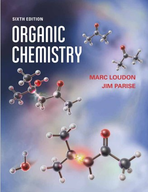Identify each of the following compounds from their spectra. (a) Compound A: molecular
Chapter 21, Problem 21.55(choose chapter or problem)
Identify each of the following compounds from their spectra. (a) Compound A: molecular mass 113; gives a positive hydroxamate test; IR 2237, 1733, 1200 cm1 ; proton NMR: d 1.33 (3H, t, J 5 7 Hz), d 3.45 (2H, s), d 4.27 (2H, q, J 5 7 Hz). (b) Compound B: C6H12O2; IR: 1743 cm21 ; proton NMR spectrum shown in Fig. P21.55a. (c) Compound C: molecular mass 71; IR: 3200 (strong, broad), 2250 cm1 ; no absorptions in the 15002250 cm1 range; proton NMR: d 2.62 (2H, t, J 5 6 Hz), d 3.42 (1H, broad s; eliminated by D2O shake), d 3.85 (2H, t, J 5 6 Hz). (d) Compound D: EI mass spectrum: two molecular ions of about equal intensity at m/z 5 180 and 182; IR: 1740 cm1 ; proton NMR: d 1.30 (3H, t J 5 7 Hz); d 1.80 (3H, d, J 5 7 Hz); d 4.23 (2H, q, J 5 7 Hz); d 4.37 (1H, q, J 5 7 Hz). (e) Compound E: UV spectrum: lmax 5 272 nm (P 5 39,500); EI mass spectrum: m/z 5 129 (molecular ion and base peak); IR: 2200, 970 cm1 ; proton NMR: d 5.85 (1H, d, J 5 17 Hz); d 7.35 (1H, d, J 5 17 Hz); d 7.4 (5H, apparent s). (f) Compound F: C10H13NO2; IR: 3285, 1659, 1246 cm1 ; proton NMR spectrum shown in Fig. P21.55b. (g) Compound G: molecular mass 101; IR: 3397, 3200, 1655, 1622 cm1 ; 13C NMR: d 27.5, d 38.0 (weak), d 180.5 (weak)
Unfortunately, we don't have that question answered yet. But you can get it answered in just 5 hours by Logging in or Becoming a subscriber.
Becoming a subscriber
Or look for another answer
